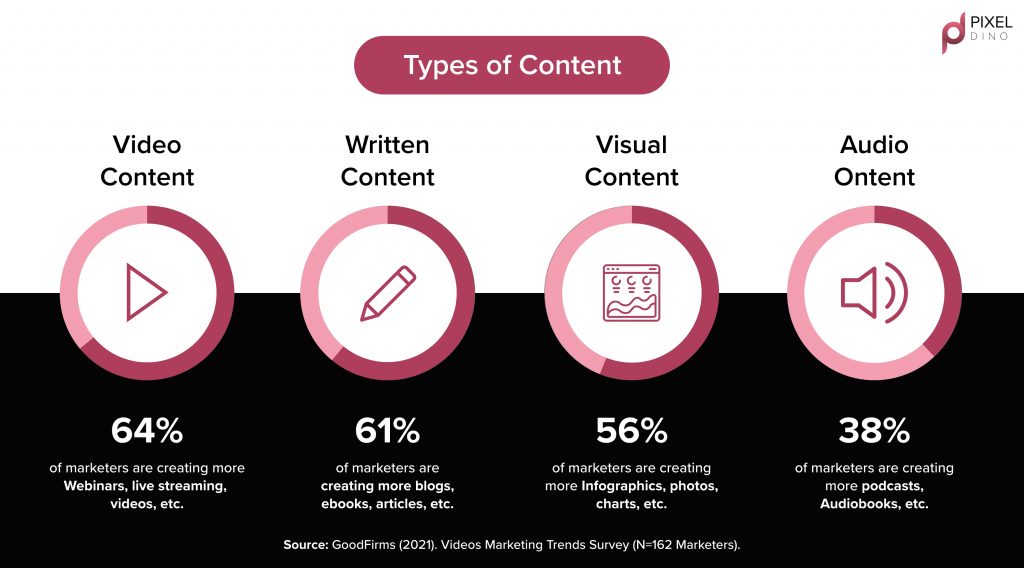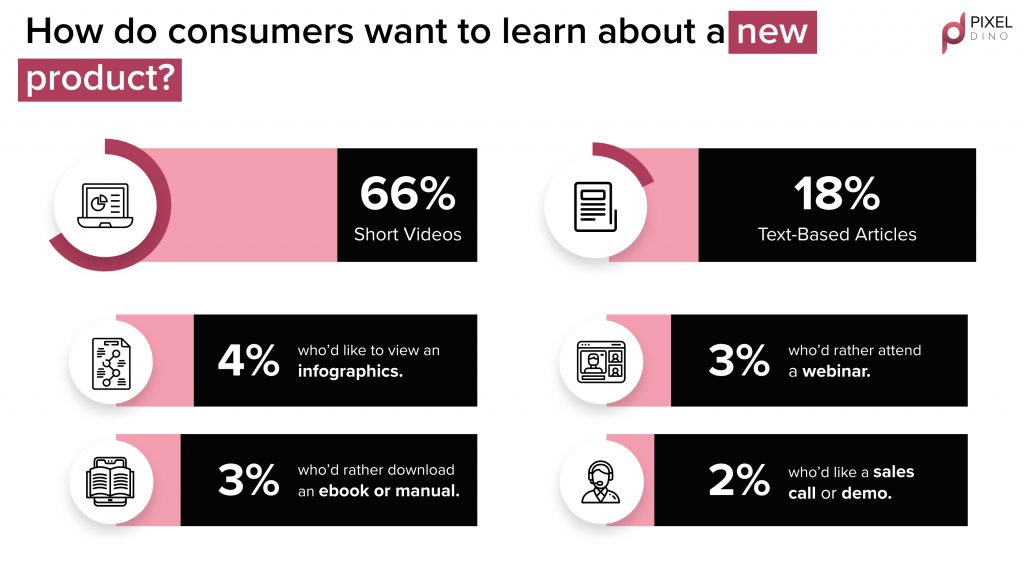Video Marketing vs Content Marketing: Pros & Cons
Content is king, but video is the one ruling the kingdom!
One of the most common debates among marketers is whether to choose video marketing or content marketing. Though both have their distinctive benefits, it is always difficult to state one winner. When it comes to marketing strategies, there is no race. It is a collaborative effort used to engage and connect with the audience.
For your marketing effort, you'll need both sorts of content, and they should complement one other if done well. After all, every video has a screenplay and description, and every major news is best preceded by a compelling video that entices viewers to learn more.
In this article, we are going to cover the pros and cons of video and content marketing so that you can make a sound decision depending on your campaign needs.
Video Marketing
Pros
1. Higher Engagement
Video marketing generates a higher engagement rate, which is why most marketers embed it in their marketing strategies.
A report from Buffer suggests that 43% of customers look for more relevant videos from brands to make their purchasing decision.
It has been observed that when it comes to video marketing, people are 10 times more interested in watching and sharing video content as compared with any other form.
Videos can increase your conversion rate up to 80% and open rate up to 19%.
2. Higher Conversion
Videos are a great way to engage with your customers, and with higher engagement, the video content amplifies your conversion rates.
Without a proper understanding of the product or service, your audience will not proceed with the purchase. So, when they visit your website you want them to understand who you are, what kind of products and services you offer, and how your customer can benefit from using them.
Video content is an advantage for marketers; this advantage may be maximized by sharing customer testimonial videos or how-to videos so that the viewers can relate and connect with the content you are producing.
Speaking of content marketing, cluttering web pages with written material might turn visitors away, so, to avoid this, you can add video content along with written text to your web pages.
Read Also: Easy Video Marketing Ideas That Will Engage Your Audience
3. Visually Appealing
If it pleases the eye, it has more room in the closet: this is a rule shoppers follow when choosing apparel. In the same way, companies too can benefit from being visually appealing.
Captivating videos will always entice the eye of the viewer, which means they will be more likely to stay involved and watch the complete video.
Good graphics engage the viewer and provide a pleasurable viewing experience, resulting in a good relationship with the brand and a desire to learn more about its products. Humans are both visual and intellectual beings, which is why a solid mix of visual and textual material is always a winner.
4. Increases Reach
Despite the fact that video is the king of content marketing, many firms have yet to include video marketing into their plan.
Producing outstanding films is expensive and time-consuming, but the market is growing increasingly crowded, and it's more vital than ever to stand out, and the only way to do so is to create engaging films that help consumers understand your brand better.
Consumers would like marketers to provide more video content, according to 53% of respondents.
5. Competitive Edge
If you are starting out in the competitive business landscape, then video marketing comes as a breeze to your journey.
Many firms would overlook video content since it is more expensive and time-consuming. This is a reasonable decision in terms of conserving time and money, but these businesses frequently miss the fact that video content has a better return on investment.
However, this doesn't mean that you have to spend all of your money on finding and creating through the greatest video material available: a little goes a long way. Even just one video may have a significant impact, so start small. Video marketing will give you a leg up on the competition.

Cons
1. Expensive Production
Video creation might put a burden on your budget depending on the equipment you employ. Given that an increasing number of businesses are adopting video marketing, everyone wants to be the best in terms of quality and aesthetics.
Written material is low-cost and simple to create. You only need a computer and a word pad to start creating textual content. You may even use your smartphone to produce written material.
There are numerous moving parts in a video. Videos may be expensive to produce, even though they offer a better return on investment.
Furthermore, if you are not experienced in video creation, it may be difficult to succeed and costly to make mistakes.
2. Time-Consuming to Produce
It is undeniable that generating video content takes longer than writing a blog post or designing a social media ad.
Unlike content marketing, where you only need a concept to get started, video production is a lengthy process that takes time to complete from pre-production to production to post-production, and you'll discover that you've spent far more time than producing written content.
A decent video requires more time and effort to develop, and it takes much longer to post if several modifications and adjustments are required after the first file is generated. However, the payoff is frequently higher than with written material, so while it's not a one-sided sacrifice, it is a gamble.
3. Not Easy to Update Video Content
This is the part where you understand the value of written content.
If something changes after you post a video, you won't be able to update it. If the update is important and might cause confusion, you must either release a new video or remove the previous one.
Written announcements are required, and they can even be written as captions to alert viewers to specific changes. A smart method to deal with this is to preserve all of your files and raw footage so that new videos can be released quickly if needed.

Content Marketing
Pros
1. Cost-Effective
Organizations, especially small-scale ones, are concerned about costs. There is no greater cost-cutter than the written word which takes barely any input to produce, without undermining its impact, if done well.
Even while video creation is getting more inexpensive as a result of the availability of low-cost devices such as cellphones, the quality occasionally suffers. This can be detrimental to your internet business, especially in today's environment of strong competition.
A video's production cost is also significantly more than that of a blog post. You will still attract more visitors and boost revenue if your content is good.
Additionally, when your business grows in popularity, you won't necessarily need to spend on "better content development." It's possible that you'll need to recruit more content writers, but that's about it.
2. Reusable Content
With textual material, you can do virtually anything, but with video content, you can expect certain limits.
For instance, by reducing the language and making the tone more informal, you may repurpose a piece of text you produced for Facebook as an Instagram caption or Tweet.
Another example, you can capture a video or produce audio material using textual content. A whitepaper may also be used to produce a series of blog entries or social media postings.
Posting the same video across all platforms, on the other hand, will not work. If your video is geared for Instagram users and has an "Instagram vibe," it may not be as appropriate for your LinkedIn profile.
3. Easy to Produce
Written content is often easier to create, especially if you have access to a skilled content writer. A blog article may be produced in a few days, but a video can take a couple of weeks to decide, record, export, direct, edit, review, and publish.
Content marketing is one of the tried and true tricks of the trade; when it comes to producing and marketing written content, all you require is research and the right insights. This is why businesses frequently use blogs and prefer textual content for smaller announcements, while video content is used for larger announcements.
You must consider which news demands a video and what can be conveyed through text.
4. Skimmable Content
Although video content can engage viewers with shorter attention spans, they are more likely to feel upset and click away if their query is not answered right away or if the initial few seconds are not fascinating enough. With an article, however, they are able to skim and search for their answers more easily and without suspense.
Moreover, even while internet videos are becoming increasingly brief, a well-written article may deliver information to your readers far more quickly.
With video content, people just don't have the time to scan through a film in the hopes of discovering what they're looking for. With written material, this is not the case. People scan through the text rather than reading it. And this is what gets people to stay more engaged with your content.
5. Boosts Search Engine Rankings
You can't spread your SEO keywords across a video, no matter how appealing it might look. You can only use a few keywords in the title and caption at most.
However, when we talk about written content, you can easily add several keywords throughout an article or portion of a website's content, which can substantially aid your SEO ranking.

Cons
1. Lacks Visual Pace
Talking about written content, you can surely try to add photos and infographics to your articles to make them more interesting, but when compared with videos, they are rarely as engaging. This is the reason many customers prefer videos over articles. Moreover, videos are generally more attractive and conversational.
Videos, without a doubt, are more aesthetically attractive. With a diverse set of elements available to use, from motion graphics to animated characters, videos have the power to hold and capture viewers' interest.
2. Reading is not everyone’s first choice
Some individuals simply do not enjoy reading, and there is nothing you can do about it. People will devote more time to viewing a video than reading text. Analytics suggest that people often simply scan through posts and only read the headlines, and a large chunk of the content is never viewed.
People's attention spans have shrunk, and they respond better to visuals than to text. Thus, rather than writing, consider employing video content for important notifications because consumers are more likely to click on a video than an article.
3. Difficult to Emphasize Pain Points
It's simpler to accentuate the most important aspects of a video with graphics and sound. When working with text, this is more challenging, especially when dealing with longer reads.
You can achieve this aim with photos, typefaces, and even infographics, but you risk going overboard and making your post look ugly.
Conclusion
Every marketer knows that content marketing is here to stay and that it has a significant impact on prospects, sales possibilities, and even consumers.
And, because the video is so engaging, there's no question that video marketing boosts clicks, produces more traffic, and drives sales, which is why so many businesses are turning to video marketing now more than ever.
Although video content is appealing and entertaining, we cannot overlook the importance of well-written and evergreen articles, especially when dealing with complicated themes.
The bottom line is that while deciding which format to employ for marketing a brand, one should consider the target market.